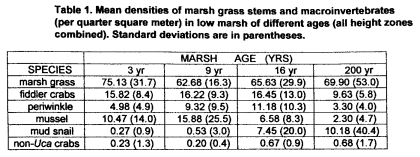
John Walsh, Dept. of Environmental Sciences, University of Virginia
According to aerial photographs and available maps, salt marshes have existed along the western shore of Hog Island, Virginia, for at least 124 years. These fringing marshes, which are dominated by the grass, Spartina alterniflora Loisel, are wider in the northern region and narrow to the south. The Ash Wednesday storm of March, 1962 caused a massive overwash along these narrower, southern marshes, either burying them in a meter or so of sand or washing them away completely.
Subsequent aerial photographs and maps,which chronicle the return of marshes to the area, were used to choose four sampling sites along this chronosequence. Plots were set up in marshes of approximately 3 yr, 9 yr, 16 yr, and 200 yr of age. Each plot is 20m wide and extends the length of the low marsh, that area that is dominated by Spartina alterniflora. Within each plot, a one-quarter square meter quadrat was randomly tossed 20 times in each of the three Spartina height zones (tall, medium,short), and the densities of the major macroinvertebrates noted. These densities were analyzed by individual species (ANOVA) and by entire assemblage (PCA).
General trends were observed for changes in the densities of individual species within the entire low marsh, with marsh age (Table 1). The following organisms showed a general decline with marsh age, especially from 16 yr to 200 yr marsh: Spartina (stems), fiddler crabs (Uca), marsh periwinkles (Littorina), and ribbed mussels (Geukensia). However, the densities of the mud snail (Ilyanassa) and non-Uca crabs (Sesarma, Panopeus, and Callinectes) increased with marsh age (Figure 1). The most dynamic of the three Spartina height zones was the tall zone. The following shows the percentage difference in organism density in the tall zone between the 3 yr marsh and the 200 yr marsh: Spartina (-50%), fiddler crabs (-63%), periwinkle (-96%), ribbed mussel (-100%), mud snails (+2800%), and non-Uca crabs (+700%). The depauperate macroinvertebrate fauna of the tall zone of the mature marsh may be due to a lower elevation there (and hence greater tidal inundation time) than in the younger marshes, leading to increased predation opportunities by fish and the abundant predatory crabs. Of the three height zones, the medium zone showed the least variation in macroinvertebrate densities with marsh age, while the short zone showed a variety of density patterns.
Results of a PCA performed on the raw data indicate that periwinkle, fiddler crab, and mussel densities have the greatest impact on data variation. This PCA also confirmed that the macroinvertebrate communities of the three height zones demonstrate different patterns of change with time.